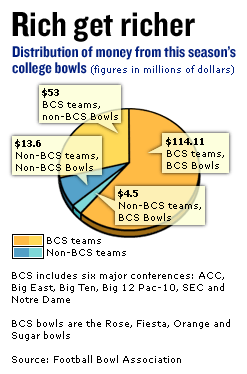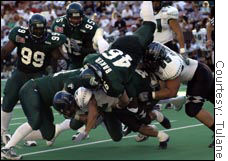
NEW YORK (CNN/Money) -
The college bowl system does a questionable job of picking the nation's best football team, and even a worse job producing the best financial return for teams both large and small that take the field.
The bowl system is a center of controversy once again, as the University of Southern California, the No. 1 rated team in the country in the polls, isn't getting a chance to play in the so-called championship game.

But even in years without a controversy over the best team, the current system is costing many teams that participate money and leaving the big and small conferences fighting over slices of a revenue pie that is smaller than the one a playoff system would produced.
The 29 bowls are a hearty breed, fed by entrenched interests in athletic departments and chambers of commerce across the nation. Most teams with winning records get to attend a game, even though most of the games determine nothing more than bragging rights. And most of the teams that play get to pay for the privilege of going to a bowl, rather than seeing a financial windfall that a playoff system could produce for all Division 1A teams.
The fact is that the bowls provide far more help to the hospitality industry than to the teams that play in them. Bowls have strict rules on how many days a team must stay in town and how many tickets the attending schools must buy.
 |
|
| Tulane University was lucky to break even with its trip to the Hawaii Bowl last season. This year it'll make more money from staying home and sharing in fees paid to other teams in its conference. |
The organizers, generally not-for-profit organizations set up with support from the business community in their home cities, are concerned enough about filling hotel rooms that many second-tier bowls would rather remain second tier than become an early round game of an 8- or 16-team playoff system. That's true even though being part of a playoff would mean far more attention, television money and the chance to host the nation's best teams.
Bowl organizers fear that if they were early round playoff games, many schools' fans wouldn't travel to see the contests, and the tickets would end up being bought by locals, not visitors. Teams and their large traveling parties also wouldn't be willing to spend four or five days in town before a playoff game, since teams could face three or four rounds to win a championship, rather than a single game.
"The benefits to the communities of hosting the bowl games are not going to be there [with a playoff]," said Mike Schulze, spokesman for both the Outback Bowl and the Football Bowl Association.
A playoff system also would likely kill many of the lesser bowls, sucking up much of their television money and fan interest. That would mean only a fraction of the 58 teams in a bowl this year would get a chance to extend their season. That greatly limits support in athletic departments for shaking things up.
Tulane University President Scott Cowen has become one of the leaders of a movement to spread bowl money more evenly between the powerhouse and non-powerhouse conferences. The six major conferences that participate in the Bowl Championship Series that selects a national champion keep the overwhelming majority of the $184.6 million to be paid out by bowls this year.
| SportsBiz
|

|
| Click here for SI.com sports coverage
|
|
|
|
The 63 schools in the BCS not only keep $111.4 million of the $118 million paid out by the four big-money BCS bowls -- the Rose, Fiesta, Sugar and Orange bowls -- they also get the lion's share of the rest of the money -- about $53 million for grabbing 32 of the 48 spots open in the non-BCS bowls.
That leaves crumbs -- about $14 million to be spread among the other 54 1A schools not in the BCS conferences in order to have 16 teams from those conferences go to bowls, plus about $4.5 million that those conferences get from BCS.
| Related columns
|

|
|
|
|
Financial considerations can't be ignored at Tulane and many other non-powerhouse schools going to bowls. Tulane considered dropping its Division 1A football program earlier this year due to losses. The most recent figures available, for the 2001-2002 school year, show it lost $3.7 million, including the cost of scholarships. Even without the scholarships, it would have lost $1 million. Eight other schools in bowls last season also reported football losses on their most recent statements, and six more were only marginally profitable.
Cowen and dozens of other presidents from outside the BCS are pushing those six conferences and even Congress to spread the wealth more evenly, and give the lesser conferences a chance they don't have now at winning a national championship. He's even talked about an antitrust suit to break up the BCS.
But given the special interests among athletic departments and bowl organizers, let alone the six major conferences, it's going to be tough to ever break up the current money-losing bowl system and replace it with a playoff system that could provide far more money for teams both large and small.

|

